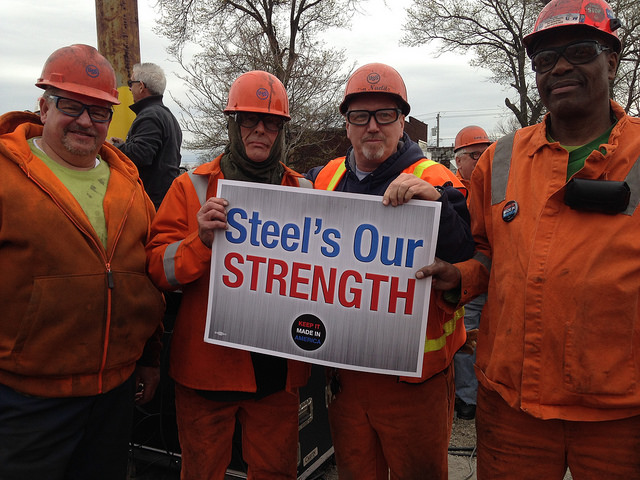
But despite capacity cuts, overcapacity in Chinese steel is on the rise.
Last week we noted how an international group of steel industry associations had released a statement, calling on their governments to figure out a way to reduce steel production overcapacity – the difference between an industry’s potential output and current production.
They released it ahead of a meeting of the G20 Global Forum on Steel Excess Capacity, which convened in Japan over the weekend. That forum was created in 2016 to find some international consensus on how to fix the overcapacity problem, which is (not entirely but) mostly a problem created by China’s massive steel industry.
The Chinese government might dismiss that as an outsider’s biased opinion, but consider the context in which China’s steel industry grew. In the early 90s it became a “strategic” industry in government planning documents. According to an analysis of the industry produced a few years ago at AAM’s behest by Duke University, “state direction, supplemented by state subsidies, incentives, and strong internal demand for steel, had an important role in developing China’s steelmaking capacity.”
And so it went from responsible for a fraction of global production in 2000, when it produced 129 million metric tons (MMT), to approximately half of production in 2015, when it produced 804 MMT. While most of that Chinese steel was consumed in China – the country spends a lot on infrastructure as a form of economic stimulus, and infrastructure requires steel – its considerable excess spilled out into the international market, depressing prices and triggering bankruptcies and layoffs. This was essentially the preamble to the import tariffs the Trump administration finally raised on steel in 2018.
So back to this weekend’s G20 steel forum: Was any news created during this meeting? Anything of note?
The answer is: Yes. China announced it will no longer participate in the forum. Its membership will lapse in December and it will just kinda peace out. The South China Morning Post writes:
China’s Ministry of Commerce said in a statement on Saturday evening that China had made “the greatest and most outstanding” contribution to global efforts to reduce excessive steel capacity as it was the only country that had imposed a mandatory target upon itself.
“China has slashed total steel production capacity by more than 150 million tonnes since 2016, or 114 per cent of the global steel capacity cut … and China has redeployed 280,000 steel workers, which is more than the combined deployed number of steel workers in the US, the EU and Japan,” according to the ministry.
That is a huge amount of production capacity, to be sure. But, again, context is important: China may have taken 150 million tons worth of annual production offline and “redeployed” 280,000 workers, but the American steel industry – still one of the largest steel producers by volume in the world – only produced 116 million metric tons of during the entirety of 2017, while China produced 831 MMT. Even after China shut down steel mills capable of producing 150 million tons annually, it’s still by a huge margin the world’s largest steelmaker with the world’s largest steel production capacity.
Anyway, the Chinese government this weekend also argued that overcapacity in the steel industry was ultimately the result of a “demand slump following the financial crisis of 2008” and the burden on addressing it shouldn’t be entirely China’s problem.
But that diagnosis is convenient and only tells half the story. The other half of it is the heavy involvement of the government in the direction of the Chinese steel industry, which created this mess in the first place, and its inability to rein in production by mills that aren’t state-owned.
A story from Nikkei last month recounted the detainment of the general manager of a large, state-owned steel mill in the industrial city of Tangshan near Beijing. The mill had been ordered to halve its production because of environmental concerns.
“But the company reportedly ignored it and continued to boost production,” Nikkei writes:
(The company) has made a show of complying with the mandate. Following the manager's arrest, digital signage outside the mill's entrance displayed the words "Blast Furnace 2 suspended."
While the authorities "may have shown their degree of seriousness when they went after a major player, there is almost no effort to abide by production cuts at small to midsize companies," a steel market insider said.
As such, Chinese steel production is actually increasing. reports Reuters:
In the first eight months of 2019, the world’s top steelmaker churned out 665 million tonnes of crude steel, up 9.1% on the year.
Production by members registered with the China Iron and Steel Association (CISA), mostly state-owned firms, grew at 5.9% year-on-year during that period. Production by non-members, mostly private firms, surged 19.4%, according to CISA.
And Platts points out that even as China shutters older, slower, dirtier mills, it is replacing them with mills that are much more efficient. That, and discrepancies in accounting for offline mills toward its capacity total mean that Chinese steelmaking capacity is indeed increasing. And it won’t be ending anytime soon:
It is considered unlikely that Beijing will order another round of capacity elimination as Chinese steel works are mostly equipped with up-to-date technology and meet environmental protection standards.
So China is tipping out of the steel overcapacity forum, but make no mistake: This is a problem of China’s making.
No! It's not!
